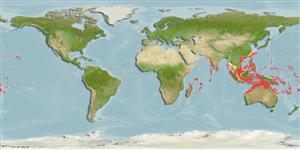Environment: milieu / climate zone / depth range / distribution range
Ecologie
marien rifbewoner; standvastig; diepte 10 - 120 m (Ref. 9710), usually 25 - 120 m (Ref. 9710). Tropical; 28°N - 24°S, 46°E - 156°W (Ref. 5222)
Indo-Pacific: scattered insular localities from the Comoros to the Line Islands. Unknown from the Red Sea, coast of East Africa, Sri Lanka, Australia, New Guinea, and the larger islands of Indonesia.
Lengte bij maturiteit / Grootte / Gewicht / Leeftijd
Maturity: Lm ?, range 25 - ? cm
Max length : 43.0 cm TL mannelijk / geslacht onbekend; (Ref. 5222)
Dorsale stekels (totaal): 9; Dorsale zachte stralen (totaal): 14-16; Anale stekels 3; Anale zachte stralen: 8 - 9. Characterized by yellow to greenish yellow color; head, body and fins with bright blue stripes; body scales ctenoid, including abdomen; pelvic fins, 1.5-1.9 in head length; greatest depth of body 2.7-3.1 in SL; truncate caudal fin to slightly emarginate (Ref. 90102); eye diameter subequal to interorbital width and about twice the depth of the preorbital; rounded preopercle, finely serrate, lower edge with 1-3 broad serrae; subopercle and interopercle finely serrate; maxilla reaches approximately to vertical at rear edge of eye; pectoral fins subequal to pelvic fins, pectoral fin length contained 1.5-1.9 times in HL (Ref. 089707)
Sporadic distribution (Ref. 48635). Occurs only at oceanic islands. Inhabits clear waters of steep drop-offs; rarely seen in less than 30 m. It has been taken in depths of 120 m and may occur deeper. Also found in caves and crevices. Often swims upside-down against the roofs of caves or archways (Ref. 37816). Feeds on fishes and crustaceans (Ref. 89972). Solitary (Ref 90102).
Levenscyclus en paargedrag
Maturiteit | Voortplanting | Paaien | Eieren | Fecunditeit | Larven
Heemstra, P.C. and J.E. Randall, 1993. FAO Species Catalogue. Vol. 16. Groupers of the world (family Serranidae, subfamily Epinephelinae). An annotated and illustrated catalogue of the grouper, rockcod, hind, coral grouper and lyretail species known to date. Rome: FAO. FAO Fish. Synop. 125(16):382 p. (Ref. 5222)
Status op de Rode Lijst van het IUCN (Ref. 130435)
Gevaar voor de mens
Harmless
Gebruik door de mens
Visserij: visserij voor eigen gebruik; sportvis: ja
Meer informatie
ReferentiesAquacultuurAquacultuurprofielKweeklijnenGeneticaElectrophoresesErfelijkheidZiektesVerwerkingNutrientsMassaconversie
Tools
Speciale rapporten
Download XML
Internetbronnen
Estimates based on models
Preferred temperature (Ref.
123201): 20.7 - 28.2, mean 26.5 °C (based on 670 cells).
Fylogenetische diversiteitsindex (Ref.
82804): PD
50 = 0.5000 [Uniqueness, from 0.5 = low to 2.0 = high].
Bayesian length-weight: a=0.01259 (0.00590 - 0.02687), b=3.04 (2.87 - 3.21), in cm total length, based on LWR estimates for this Genus-body shape (Ref.
93245).
Trofisch niveau (Ref.
69278): 4.2 ±0.7 se; based on size and trophs of closest relatives
Weerstandsvermogen (Ref.
120179): Gemiddeld, minimale populatieverdubbelingstijd 1,4-4,4 jaar (Preliminary K or Fecundity.).
Fishing Vulnerability (Ref.
59153): Low to moderate vulnerability (33 of 100).
Nutrients (Ref.
124155): Calcium = 42.8 [25.3, 73.4] mg/100g; Iron = 0.532 [0.307, 0.994] mg/100g; Protein = 18.5 [16.7, 20.1] %; Omega3 = 0.175 [0.112, 0.276] g/100g; Selenium = 41.6 [23.3, 69.6] μg/100g; VitaminA = 156 [58, 488] μg/100g; Zinc = 0.743 [0.536, 1.183] mg/100g (wet weight);
